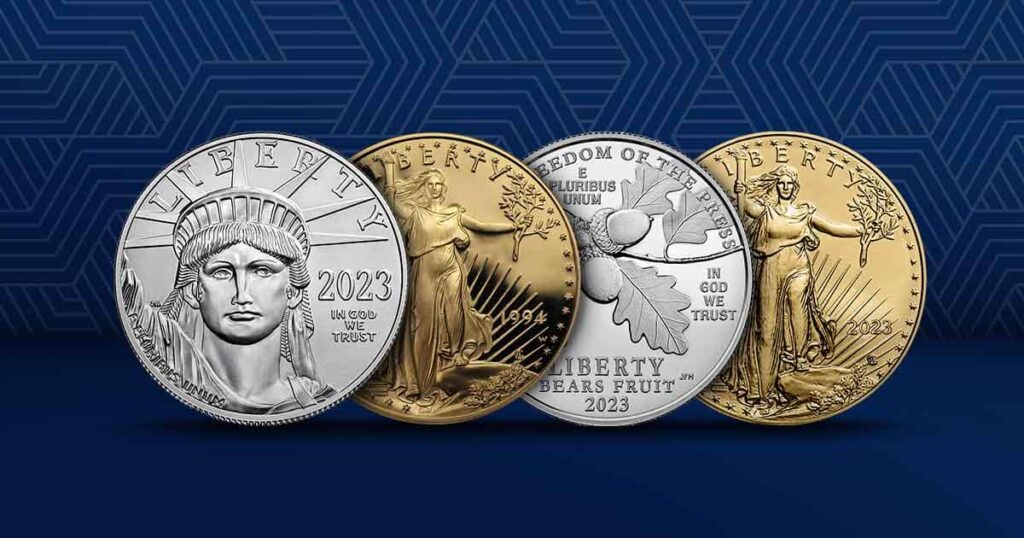
Bullion vs Proof Coins
For centuries, investing in precious metals has been a popular strategy for preserving wealth and hedging against economic uncertainties. Bullion and proof coins are two common investment forms in the precious metal market. While both types represent tangible assets and contain the same precious metal content, they differ significantly in production methods, appearance, collectability, and investment purposes.
You can tailor your precious metal portfolios to match your financial objectives and risk tolerance by carefully considering the unique characteristics of bullion vs proof coins. Whether you are seeking a straightforward means of acquiring precious metals or aiming to combine artistry and investment potential, understanding the distinctions between these two coin types can lead you to well-informed decisions in the dynamic and intriguing world of precious metal investing.
Bullion Coins: The Cornerstone of Precious Metal Investments
Bullion coins are the foundation of most precious metal investment portfolios. They are minted to provide a convenient and cost-effective way for you to acquire precious metals like gold, silver, platinum, and palladium. An example of popular bullion coins in many collections is the Gold American Eagles and Silver American Eagles. Bullion coins typically contain a specific weight and fineness of the metal, and their value is primarily determined by metal spot prices.
The Production Process
Bullion coins are struck in large quantities using traditional minting processes. Due to the focus on efficiency and mass production, bullion coins have a more straightforward and less labor-intensive minting process than proof coins.
Design and Finish
The designs on bullion coins are comparatively simple, with less attention to intricate details. They have a standard finish and may exhibit minor imperfections from the striking process, but this does not impact their metal content or value.
Pricing
Bullion coins are sold at a premium above the spot price. What is the premium over spot? The premium covers the minting cost, distribution expenses, and the profit margin for the dealer.
Proof Coins: Merging Artistry and Investment
Proof coins represent the epitome of minting craftsmanship and numismatic artistry. Producing proof coins is a meticulous and time-consuming process, creating coins with exceptional beauty and detail. While they also contain precious metal content like bullion coins, proof coins are not intended primarily for investment but rather for collectors and enthusiasts. For example, the American Silver Eagle coin is available in proof finishes – making a classic even more popular among collectors and investors.
The Production Process
Minting proof coins involves multiple strikes on specially polished planchets using carefully maintained dies. This process often results in high-quality coins with a mirror-like background and frosted, highly detailed designs, elevating their aesthetic appeal.
Design and Finish
Proof coins boast intricate designs, highlighting every detail of the artwork with unparalleled precision. The immaculate finish and high craftsmanship make them highly sought after by collectors and investors.
Pricing
Due to the labor-intensive and time-consuming production process, proof coins cost more than bullion coins.
Collectability and Rarity
While bullion and proof coins can appreciate over time, the collectible aspect sets them apart. Bullion coins’ value is primarily tied to the intrinsic value of the precious metal. In contrast, proof coins may gain additional value due to their scarcity, artistic appeal, and historical significance.
Proof coins are often issued in limited quantities, with special editions and commemorative themes, making them particularly appealing to collectors. The rarity and exclusivity of certain proof coins can drive up their value significantly.
Though not specifically designed for collecting, bullion coins can also hold some collectible value if they have historical significance, minting errors, or other unique features. However, their value is still predominantly tied to the metal’s spot price.
Investment Considerations
When deciding between bullion vs proof coins for investment purposes, several factors should be considered:
Market Goals
If you seek a straightforward, cost-effective way to acquire precious metals, you may prefer bullion coins. They may offer more direct exposure to the metal’s price movements.
Long-Term Potential
While bullion and proof coins can appreciate over time, proof coins have the potential for greater price appreciation due to their collectability and limited mintage.
Risk Tolerance
The precious metal market can be volatile, so you should consider the investment horizon before purchasing. With lower premiums, bullion coins offer more liquidity and flexibility for those needing to sell quickly in response to market conditions.
Bullion vs Proof: The Bottom Line
Both bullion coins and proof coins have unique attributes and appeal to diverse types of investors. Bullion coins are a practical and cost-effective way to invest in precious metals. In contrast, proof coins combine numismatic artistry and investment potential, making them attractive to collectors and long-term investors. Understanding the differences between these two investment forms can help you make well-informed choices aligned with your financial goals and risk tolerance.




